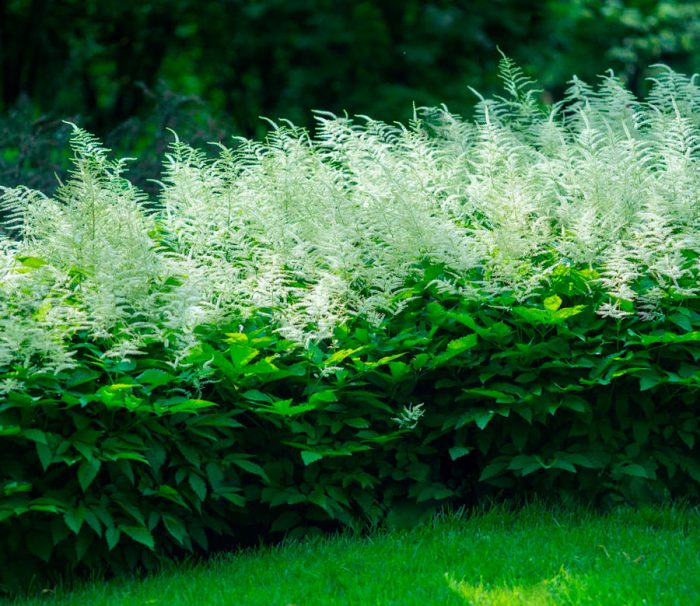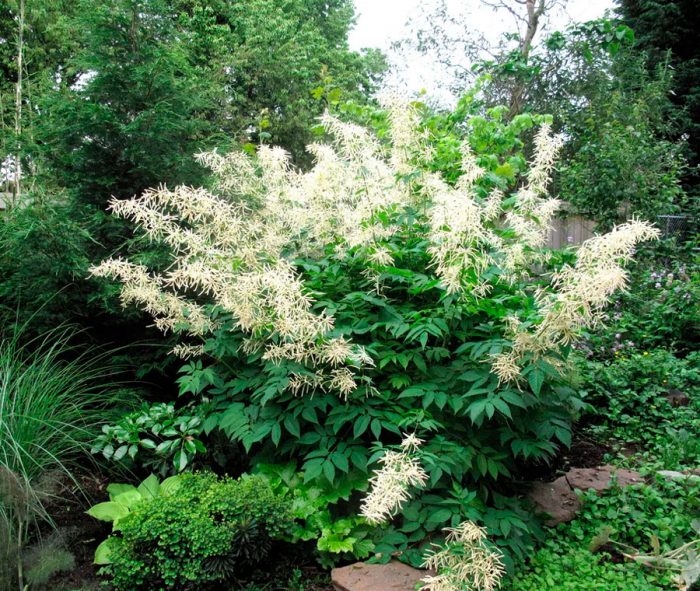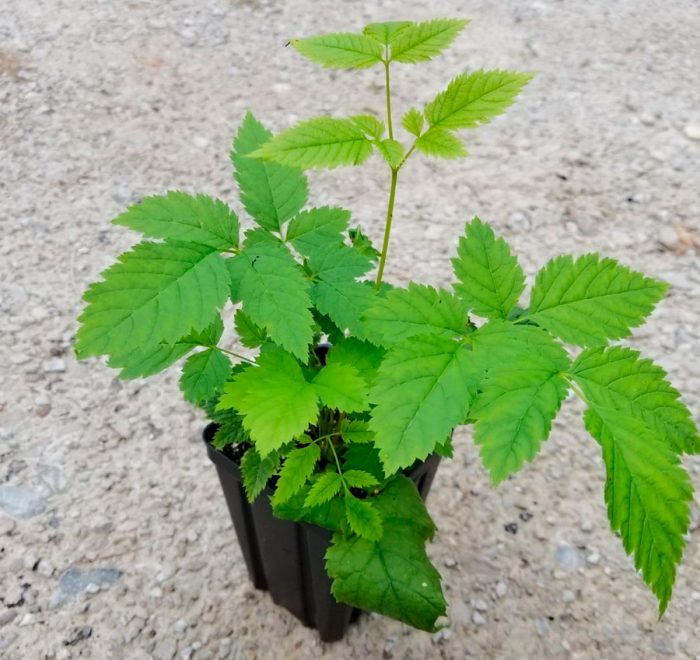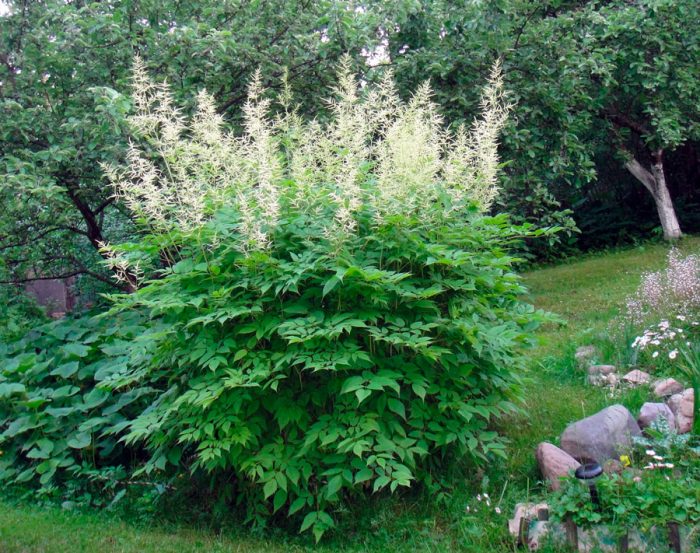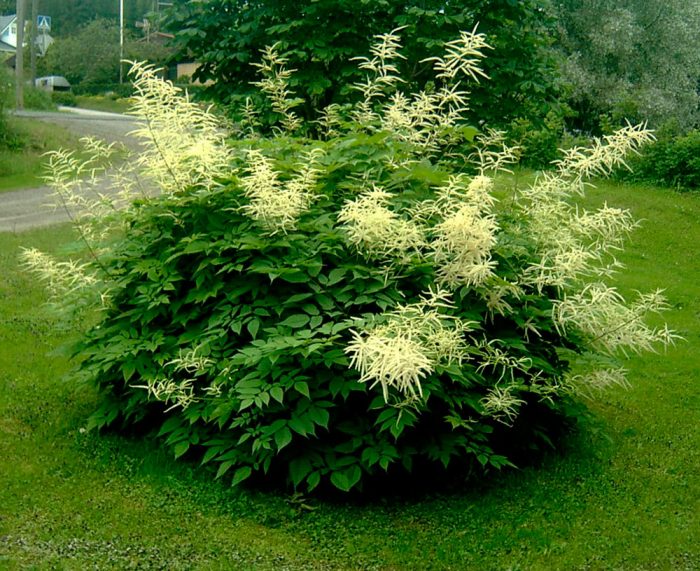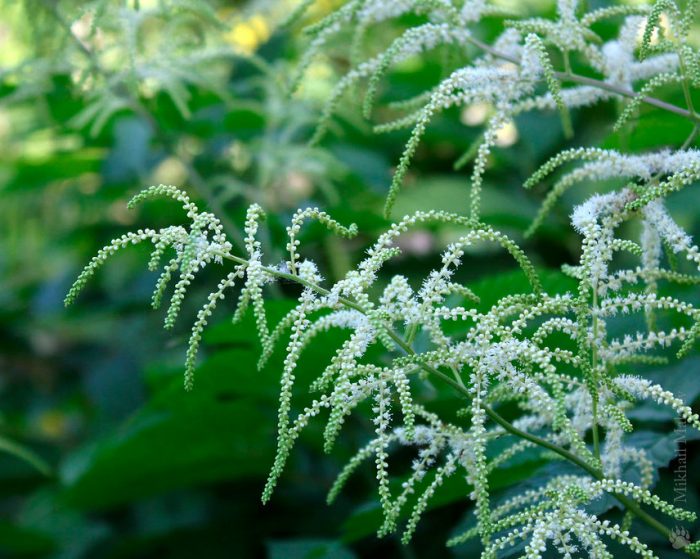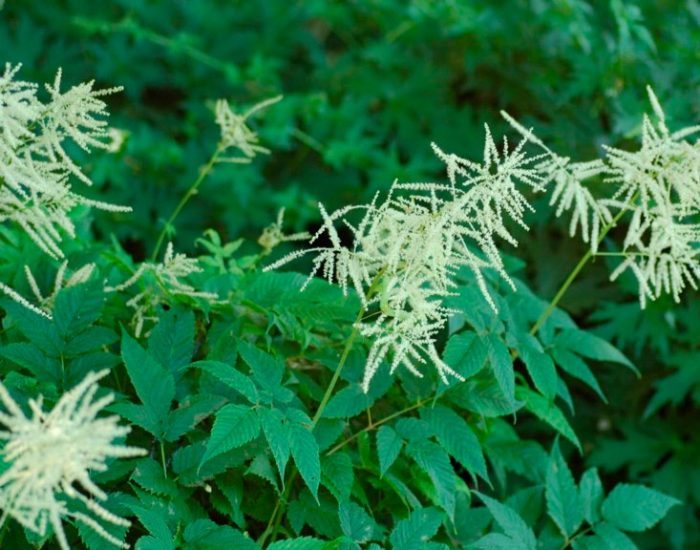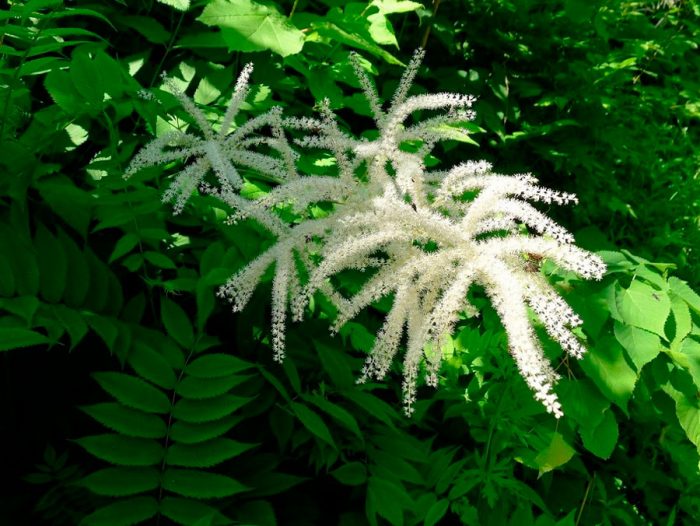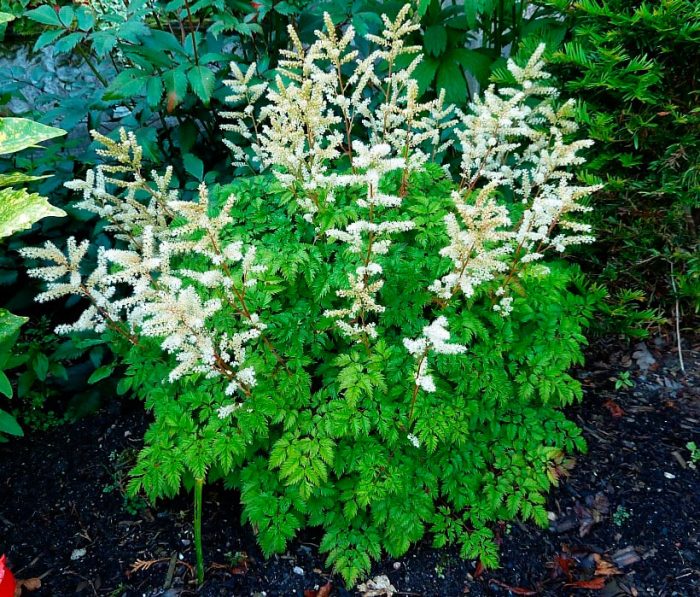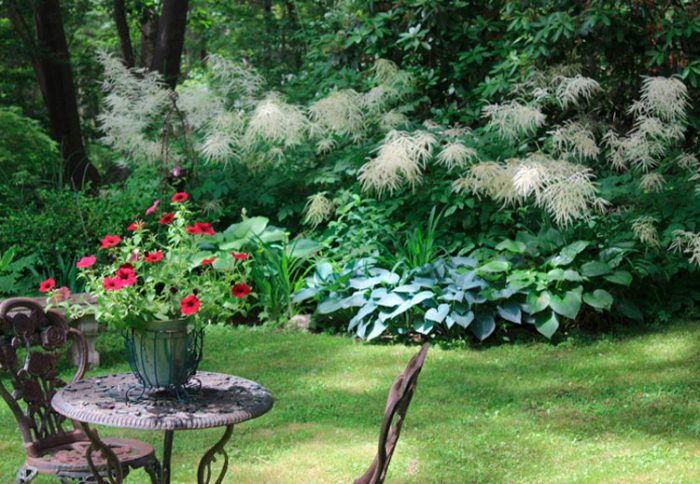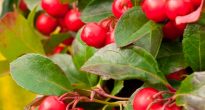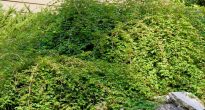The herbaceous plant aruncus is a member of the Rosaceae family. In summer, a lush bush is decorated with spectacular snow-white inflorescences. Popularly, this plant is also called Volzhanka or goat's beard.
Content
Features of aruncus
Aruncus is a large herbaceous plant that is a perennial. During one season, it is able to build up a dense green mass. That is why most gardeners perceive it as a monumental shrub. In nature, it can often be found in the Northern Hemisphere in regions with a temperate climate.
The highly branched root system of this plant is superficial. With age, the diameter of the root system increases significantly, and the roots themselves lignify. In autumn, with the onset of frost, the death of skeletal branches is not observed, however, all the foliage flies around.
An adult bush has a height of 100 to 150 cm, and in diameter it reaches no more than 120 cm. However, a young aruncus does not grow very quickly. Powerful shoots are erect. The stems are completely covered with deep green leaves with carved edges, their petioles are long.
In the upper part of the branches, peduncles grow, which in length reach from 0.3 to 0.6 m. The branched spike-shaped inflorescence consists of many small sessile flowers of a cream or white color. Both female and male flowers are formed on the same bush. Female flowers are loosely arranged and have an openwork edge, while male flowers grow more densely and look more magnificent. In size, the flowers reach about 0.3 cm. They have a pale green tint due to prominent perianths. Bushes bloom from June to early July. The flowers have a sharp, tart aroma that attracts insects to the garden. In the first weeks of autumn, fruits are formed, which are leaflets, inside which are dust-like seeds.
Reproduction of aruncus
Growing from seeds
Growing Aruncus from seed is easy, but harvesting mature seed is not easy. Pollination of flowers is complicated by the fact that the plant is dioecious. The very small leaflets contain dusty seeds.
Trim the inflorescence carefully and place it in a paper bag. There he should be until the moment, until it dries completely. After that, all the seeds are poured out of it.
Sowing seeds of aruncus is carried out in the first spring weeks, using large boxes filled with substrate. In southern regions with a mild climate, sowing is carried out directly into the open ground before winter. After the seedlings have formed 2 pairs of true leaf plates, they should be cut in such a way that the distance between them is from 10 to 15 centimeters. After 1 year, the grown seedlings are planted in open ground immediately to a permanent place. Do not forget to maintain a sufficient distance between the bushes.
Remember that after the plant is 2 years old, it will no longer be possible to transplant it. The fact is that its root system is lignified, and besides, it also grows strongly in width. The first time the bush blooms at 3 or 4 years.
Rhizome division
An adult bush is propagated by dividing the rhizome in the first spring weeks, before sap flow begins. Remove some of the roots from the ground and cut them from the parent shrub. Remember that the roots of the aruncus are stiff, so you can only separate them with an ax or a very sharp knife. Each of the divisions should have filamentous roots and 1 or 2 buds. Cut sites should be treated with sulfur, wood ash or crushed coal. Immediately after this, land the segment in a new place, avoiding overdrying. A bush that has grown from a delenka often begins to bloom in the year of transplantation.
Aruncus care
Aruncus is a shade-loving perennial, in which, in bright sunlight, the leaf plates dry out, and the growth of the shoots becomes slower. It grows well on any soil, however, it must be watered systematically and abundantly. During active growth and flowering, it is recommended to feed it with organic matter. In the autumn, feeding is not carried out.
Do not forget to regularly cut off the inflorescences that have begun to fade. And in autumn, all shoots are shortened to about 50 mm. The surface of the soil near the plant for the winter is covered with a layer of mulch (peat and rotted leaves).
Aruncus is distinguished by its frost resistance, unpretentiousness and resistance to mechanical damage. It is also resistant to disease, but pests such as ticks, aphids and caterpillars can settle on it. You can get rid of them with a solution of an insecticidal drug (for example, Intavira or Aktelika) or a decoction of burdock.


Watch this video on YouTube
Types of aruncus with photos and names
Aruncus dioecious
In mid-latitudes in the open field, the most often cultivated aruncus dioecious, or ordinary. In nature, he prefers to grow in deciduous forests in shaded damp places. The height of this perennial plant can reach 200 cm. Its erect shoots are densely covered with foliage. A spreading plant in diameter often reaches more than 1.2 meters. On a long petiole, paired leaf plates grow, which are small in size. Since they are openwork, they look very much like fern foliage. A branched paniculate inflorescence has a length of about half a meter. This plant is dioecious, that is, it has male and female flowers that are formed not on one, but on different peduncles. The bush blooms in June and July. Ripening of seeds is observed in September.
This species has the Kneifi variety, which is highly decorative. Its leaves are finely dissected and have a rich green color. Long leaf petioles have a drooping shape. The bush reaches a height of no more than 0.6 meters.
Aruncus asiatic
This plant can also reach two meters in height. Its foliage is dark green and rough. Complex paniculate inflorescences reach about 0.35 m in length and consist of snow-white flowers. The inflorescences are more luxuriant than the previous species. The bush blooms in June, and its seeds fully ripen in the first days of September. This winter-hardy plant is found naturally in the northern regions.
There is an attractive variety called Fontana.A low bush (no more than 0.55 m) is decorated with drooping large paniculate inflorescences. Such aruncus prefers to grow in damp shaded places and is often decorated with artificial and natural reservoirs. Blooming is observed in June – July.
Arunkus Kamchatka
In nature, this kind can be found on the Aleutian and Kuril Islands, Kamchatka, Sakhalin and Alaska. It prefers to grow among forbs in meadows near mountain slopes or sea shores, and it also occurs on rocky embankments and rocks.
It is a dioecious perennial plant whose height can vary from 0.3 to 1.5 meters. The roots are lignified and thick. Cirrus double-dissected leaf plates are dark green in color, they are arranged in pairs on a long petiole. The length of the weakly branched compact paniculate inflorescence is about 0.2 m. Aruncus blooms in July – August. In the last days of September, the seeds ripen completely. This plant has an alpine subspecies, which is short (height about 0.3 m).
Aruncus American
Under natural conditions, it grows from North America to the Far East. In an adult plant, the height can reach 0.8–1.1 m. Its well-developed strong root system becomes 50–80 mm longer every year. The bush is actively developing lateral shoots, and it grows strongly in width.
Aruncus parsley, or etusifolius
This compact ball-shaped plant is about 25 centimeters tall. The branched snow-white inflorescences reach a height of about 0.6 meters, in shape they resemble dense finger-like stars. The bush blooms in mid-May, while the flowering duration is more than 4 weeks. During ripening, the seeds turn pale red, which, like the flowers, decorates the bushes. The openwork rich green leaf plates are finely dissected.
As a result of selection, a decorative hybrid "Perfection" was born. It reaches a height of no more than 0.3 m. Carved large sheet plates are painted in a deep green color. Snow-white inflorescences during seed ripening change their color to deep red.
Aruncus in landscape design
Aruncus is grown as a solitary plant in lawns. Dwarf varieties are used to create borders in the local area or near a reservoir.
Also, this perennial is used in group plantings along with deciduous and coniferous trees, as well as shrubs. When planted in a flower bed, such a plant stops blooming too early. And annual varieties with spectacular bright inflorescences look great against a green background.
After cutting, the inflorescences do not stand for long. However, after drying, they retain their shape well and are suitable for formulating dry compositions.
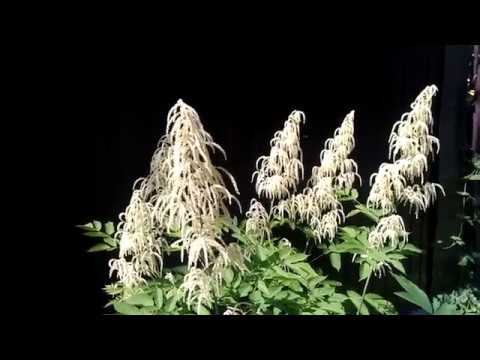

Watch this video on YouTube

